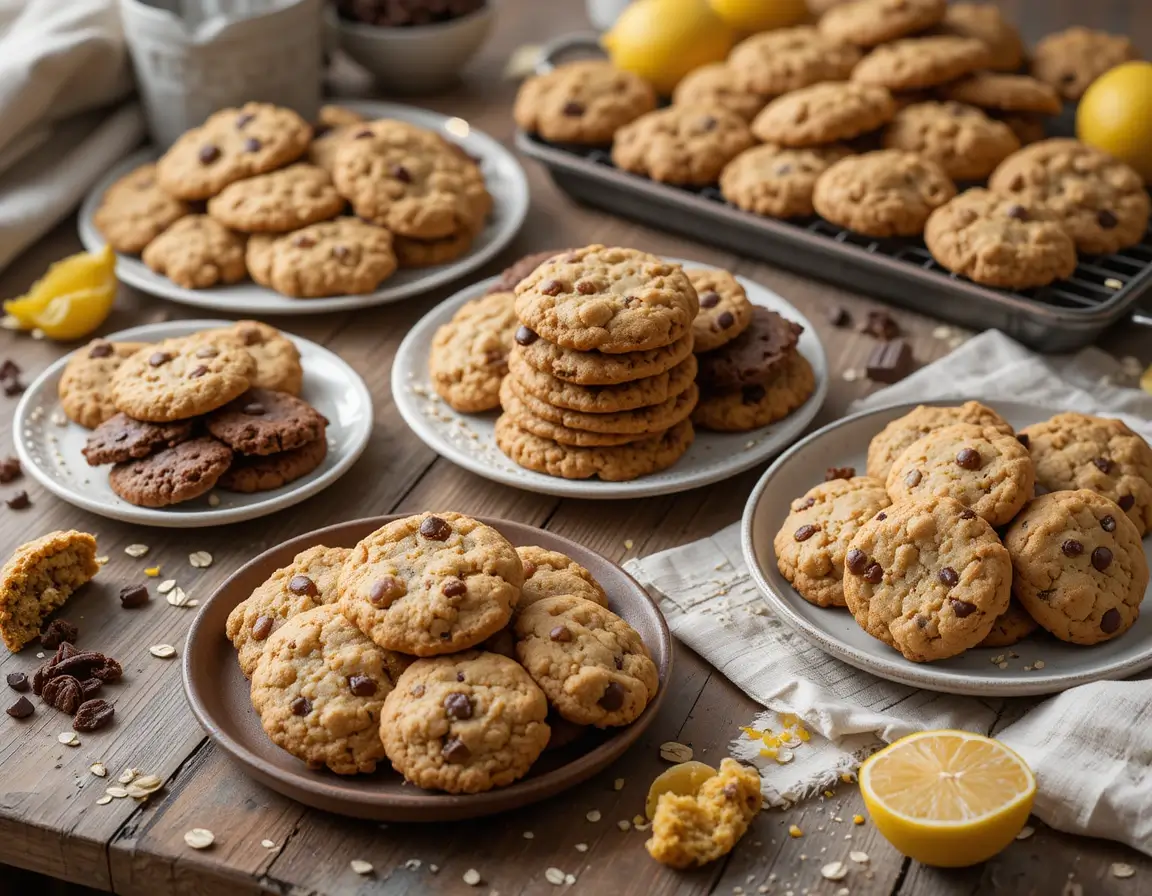15 Gluten-Free Cookies That Actually Taste AMAZING! 🤩
Table of Contents
Table of Contents
Introduction: When “Gluten-Free” Meets “Delicious”
Remember when finding a truly delicious gluten-free cookie seemed impossible? That disappointing moment of biting into what looked promising, only to be met with a crumbly, flavorless disappointment? I’ve been there, too. After my celiac diagnosis five years ago, I thought my days of enjoying truly satisfying cookies were over. But through countless experiments, failures, and eventually sweet successes in my kitchen, I discovered that gluten-free cookies don’t have to be second-rate alternatives. They can be first-choice treats that everyone reaches for – whether they avoid gluten or not!
These recipes have been tested repeatedly with friends and family who can eat regular cookies, and guess what? They couldn’t tell the difference! Some even preferred these gluten-free versions over traditional cookies. Now, I’m sharing these tried-and-true recipes so you can enjoy cookies that never compromise on taste or texture, despite being completely gluten-free.
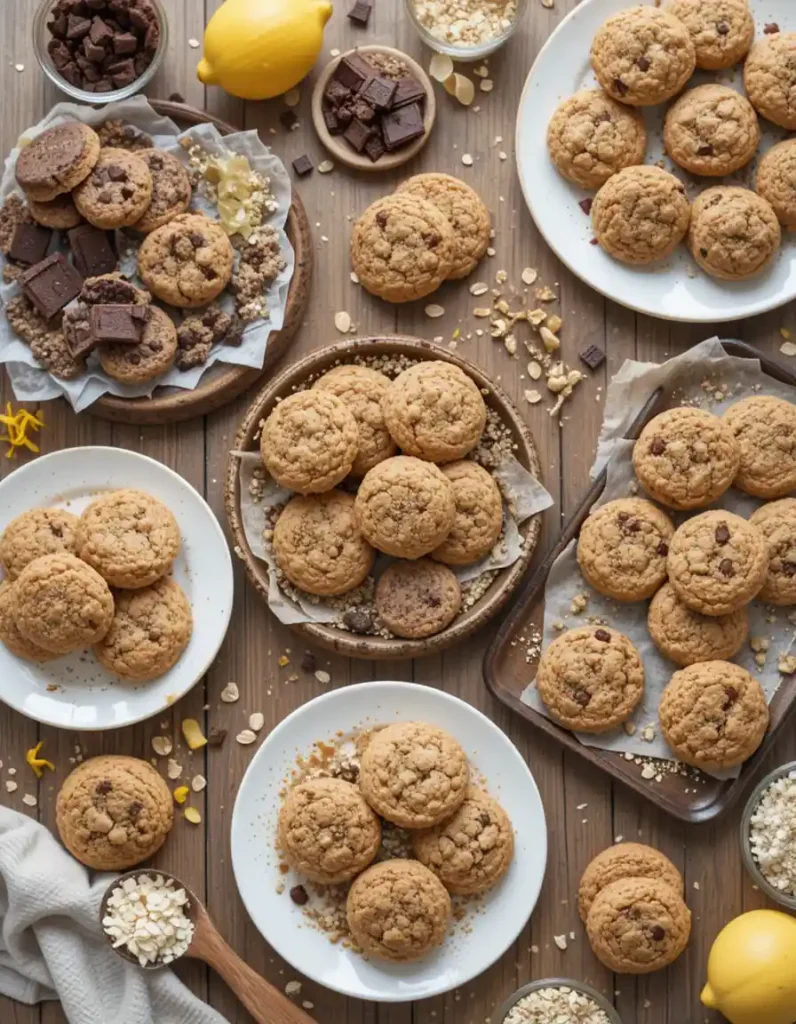
Why Most Gluten-Free Cookies Fall Short (And How These Don’t)
Many commercially available gluten-free cookies miss the mark because they focus solely on removing gluten without considering how to replace the texture and flavor it provides. The cookies in this collection use innovative ingredient combinations and techniques that address both the structural and flavor challenges of gluten-free baking.
The Science Behind Great Gluten-Free Cookies
- Flour blend variety is crucial for replicating wheat flour’s properties
- Binding agents like xanthan gum provide the necessary structure
- Moisture retention techniques prevent the dreaded dry, crumbly texture
- Temperature considerations differ from traditional cookie recipes
“The best gluten-free baking doesn’t try to imitate traditional baking—it creates something uniquely delicious that stands on its own merits.” – Renowned Pastry Chef Claire Simpson
Essential Ingredients for Gluten-Free Cookie Success
Before diving into specific recipes, let’s establish the pantry staples that will set your gluten-free cookies up for success:
Crucial Ingredients for Gluten-Free Baking
- Flour Blends
Recommended Options: Rice flour, tapioca starch, almond flour, oat flour
Function: Provide the base structure in gluten-free baking. Different flours contribute varying textures and flavors, so a combination is often used for best results. - Binding Agents
Recommended Options: Xanthan gum, psyllium husk, ground flaxseed
Function: Replace gluten’s elasticity, helping to bind the ingredients together and giving the dough or batter structure and cohesion. - Fats
Recommended Options: European-style butter, coconut oil, or shortening
Function: Contribute moisture and texture. Fats help improve the overall mouthfeel and prevent gluten-free cookies from becoming too dry or crumbly. - Sweeteners
Recommended Options: Brown sugar, coconut sugar, maple syrup
Function: Provide sweetness and moisture. These natural or refined sweeteners can also add a depth of flavor, depending on the type used. - Flavor Enhancers
Recommended Options: Vanilla bean paste, espresso powder, sea salt
Function: Add depth of flavor, creating a richer, more complex taste profile. Espresso powder can enhance chocolate, while sea salt can balance sweetness.
Equipment That Makes a Difference
- Digital kitchen scale for precise measurements
- Parchment paper for easy release
- Silicone baking mats for even heating
- Cookie scoops for uniform sizing
1. Classic Chocolate Chip Cookies (That No One Will Know Are Gluten-Free)
These cookies achieve the perfect balance of crispy edges and chewy centers that traditional chocolate chip cookies are known for.
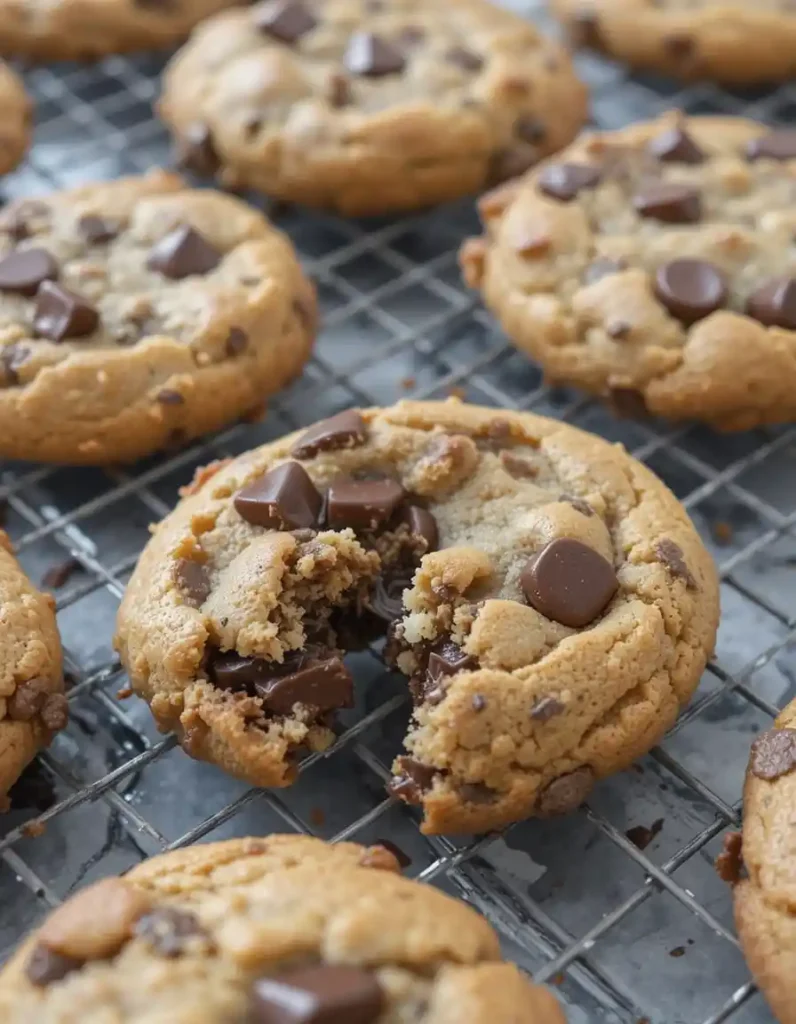
Ingredients:
- 1¼ cups gluten-free flour blend
- ½ teaspoon xanthan gum (skip this if your blend already includes it)
- ½ teaspoon baking soda
- ½ teaspoon salt
- ½ cup (1 stick) butter, melted and browned, then cooled.
- ½ cup packed brown sugar
- ¼ cup granulated sugar
- 1 large egg, room temperature
- 1 teaspoon vanilla extract
- 1 cup high-quality chocolate chunks
Instructions:
- Whisk together the gluten-free flour, xanthan gum, baking soda, and salt in a medium bowl.
- In a separate bowl, combine the cooled brown butter and both sugars. Beat until well blended.
- Add the egg and vanilla, mixing until incorporated.
- Slowly incorporate the dry ingredients into the wet ingredients, mixing only until combined.
- Fold in the chocolate chunks.
- Cover the dough and refrigerate it for at least 2 hours, preferably 24 hours.
- Preheat the oven to 350°F (175°C) and line a baking sheet with parchment paper.
- Scoop tablespoon-sized portions of dough onto the baking sheet, leaving 2 inches between cookies.
- Bake for 10-12 minutes, until edges are golden but centers still look slightly underdone.
- Let the cookies cool on the baking sheet for 5 minutes before transferring them to a wire rack.
Special Technique: Resting the dough for 24 hours intensifies the flavors and improves the texture.
2. Double Chocolate Brownie Cookies
Fudgy, rich, and intensely chocolatey, these cookies satisfy the most serious chocolate cravings.
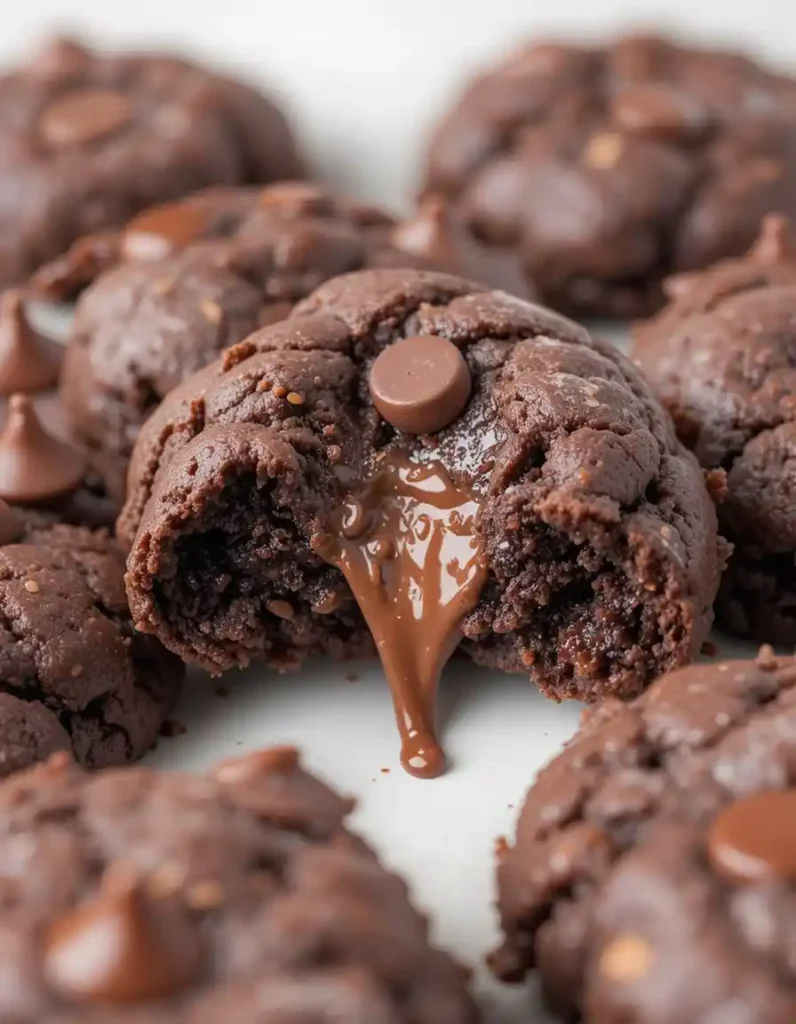
Ingredients:
- 1 cup almond flour
- ¼ cup unsweetened Dutch-process cocoa powder
- ½ teaspoon baking soda
- ¼ teaspoon salt
- 4 ounces dark chocolate, melted and cooled
- ¼ cup butter, softened
- ½ cup granulated sugar
- ¼ cup packed brown sugar
- 1 large egg
- 1 teaspoon vanilla extract
- ½ teaspoon espresso powder
- ¾ cup chocolate chips
Instructions:
- Combine almond flour, cocoa powder, baking soda, and salt in a bowl.
- In a separate bowl, beat butter with both sugars until light and fluffy.
- Add the egg and vanilla and mix until fully combined.
- Beat in the melted chocolate and espresso powder.
- Gently add the dry ingredients, mixing until just combined.
- Fold in the chocolate chips.
- Refrigerate the dough for 30 minutes.
- Preheat your oven to 325°F 165°C and line a baking sheet with parchment paper.
- Scoop rounded tablespoons of dough onto the baking sheet, leaving 2 inches between cookies.
- Bake for 10-12 minutes until the edges are set but the centers still look slightly underdone.
- Cool on the baking sheet for 5 minutes before transferring to a wire rack.
Special Technique: Slight underbaking ensures the fudgy center stays perfect.
3. Almond Flour Snickerdoodles with Cardamom
A sophisticated twist on the classic cinnamon sugar cookie.
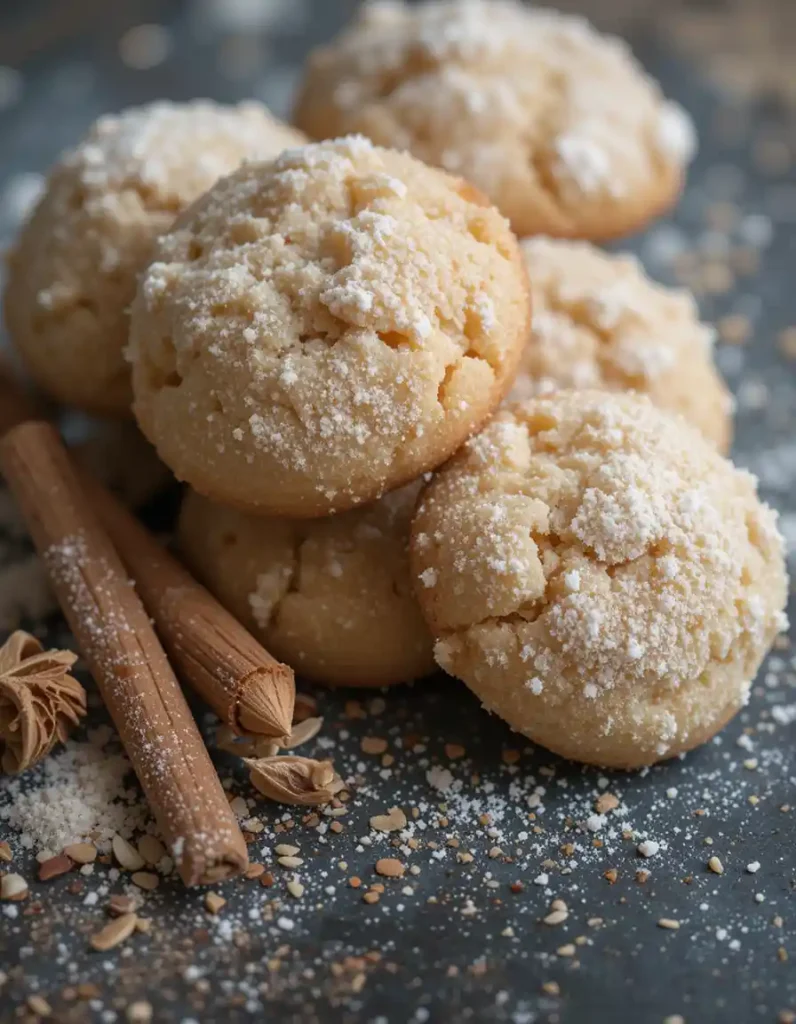
Ingredients:
- 2 cups fine almond flour
- ½ teaspoon baking soda
- ¼ teaspoon cream of tartar
- ¼ teaspoon salt
- ½ cup (1 stick) butter, softened
- ¾ cup granulated sugar
- 1 large egg
- 1 teaspoon vanilla bean paste
For the spice coating:
- 3 tablespoons granulated sugar
- 1 teaspoon ground cinnamon
- ½ teaspoon ground cardamom
Instructions:
- Whisk together almond flour, baking soda, cream of tartar, and salt.
- Beat the butter and sugar together until light and fluffy.
- Incorporate the egg and vanilla bean paste into the mixture.
- Slowly incorporate the dry ingredients, stirring until just combined.
- Refrigerate the dough for a minimum of 1 hour.
- Preheat the oven to 350°F (175°C) and line a baking sheet with parchment paper.
- Mix the sugar, cinnamon, and cardamom for the coating in a small bowl.
- Roll tablespoon-sized portions of dough into balls.
- Roll each ball in the spice mixture twice for a thick coating.
- Arrange the cookies on the baking sheet, ensuring there is a 2-inch gap between each one.
- Bake for 10-12 minutes or until the edges are set and the centers remain soft.
- Let the cookies cool on the baking sheet for 5 minutes, then transfer them to a wire rack to cool completely.
Special Technique: Double rolling in spiced sugar creates an incredible flavor crust.
4. Oatmeal Raisin Cookies with Browned Butter
These aren’t your grandma’s oatmeal cookies—they’re better!
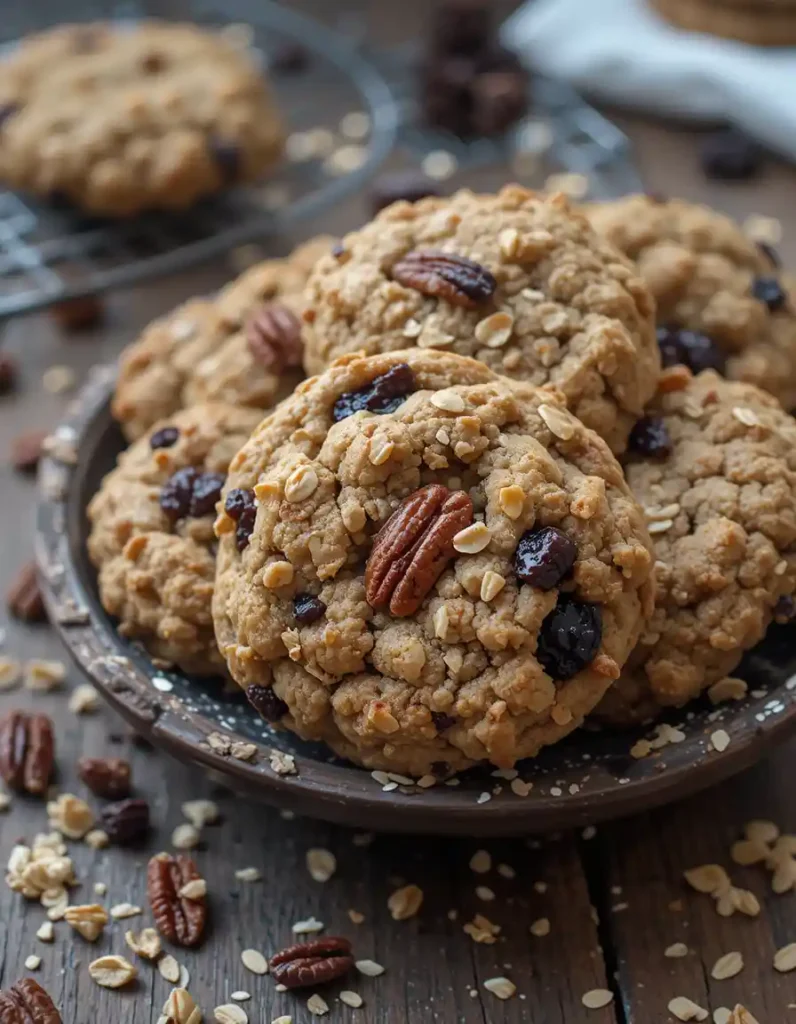
Ingredients:
- ½ cup (1 stick) butter, browned and cooled
- ¾ cup packed brown sugar
- ¼ cup granulated sugar
- 1 large egg
- 1 teaspoon vanilla extract
- 1 cup gluten-free flour blend
- ½ teaspoon baking soda
- ½ teaspoon cinnamon
- ¼ teaspoon salt
- 1½ cups certified gluten-free rolled oats
- ½ cup of raisins
- ¼ cup dried cherries
- ½ cup toasted pecans, chopped
Instructions:
- Soak raisins and dried cherries in hot water (or spiced rum) for 15 minutes, then drain.
- Combine the gluten-free flour, baking soda, cinnamon, and salt in a bowl and whisk together.
- Beat the cooled brown butter with both sugars until well combined.
- Add the egg and vanilla, mixing thoroughly.
- Slowly incorporate the dry ingredients, stirring until just combined.
- Fold in the oats, soaked dried fruit, and toasted pecans.
- Chill the dough for a minimum of 30 minutes.
- Set your oven to 350°F (175°C) and line a baking sheet with parchment paper.
- Scoop heaping tablespoons of dough onto the baking sheet, leaving 2 inches between cookies.
- Bake for 12-14 minutes or until the edges are golden brown.
- Allow the cookies to cool on the baking sheet for 5 minutes before transferring them to a wire rack.
Special Technique: Soaking dried fruit in warm spiced rum adds incredible flavor dimension.
5. Lemon Meltaways That Live Up to Their Name
These cookies are light, vibrant, and refreshing, with a melt-in-your-mouth texture.
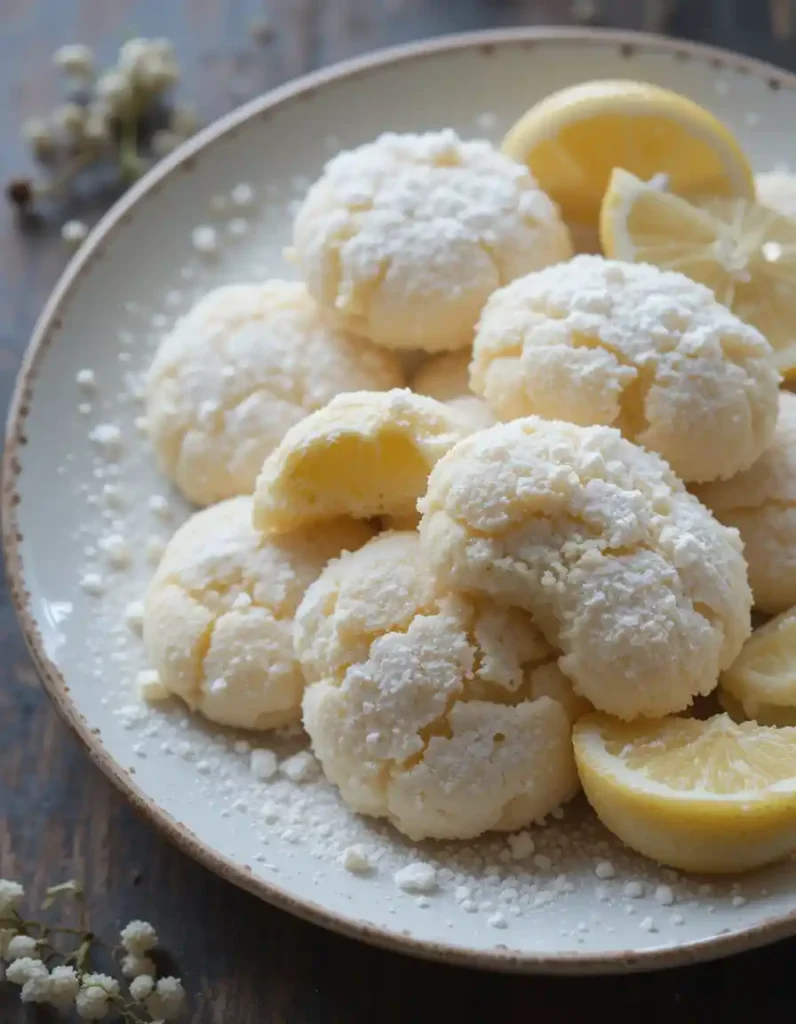
Ingredients:
- 1 cup white rice flour
- ½ cup cornstarch
- ¼ teaspoon salt
- ¾ cup (1½ sticks) butter, softened
- ½ cup powdered sugar
- 1 tablespoon fresh lemon zest
- 2 tablespoons fresh lemon juice
- ½ teaspoon vanilla extract
- Additional powdered sugar for coating
Instructions:
- Whisk together rice flour, cornstarch, and salt.
- Cream the butter and powdered sugar together until light and fluffy.
- Stir in the lemon zest, lemon juice, and vanilla until well combined.
- Slowly incorporate the dry ingredients, stirring until just combined.
- Divide the dough in half and roll each portion into a log about 1½ inches in diameter.
- Shape into a ball, wrap in plastic wrap, and refrigerate for at least 2 hours.
- Preheat your oven to 350°F (175°C) and line a baking sheet with parchment paper.
- Slice the chilled dough logs into ¼-inch rounds.
- Place the cookies on the baking sheet, leaving 1 inch between cookies.
- Refrigerate the sliced cookies for 15 minutes before baking.
- Bake for 10-12 minutes until it is barely golden around the edges.
- Cool for 5 minutes, then toss gently in powdered sugar while still warm.
- Cool completely on a wire rack, then toss in powdered sugar again.
Special Technique: Chilling the dough twice—before and after shaping.
Mastering Texture Challenges in Gluten-Free Cookies

Addressing Common Texture Problems
| Issue | Cause | Solution |
|---|
| Too Crumbly | Insufficient binding | Add 1/4 tsp xanthan gum per cup of flour |
| Too Dense | Overmixing | Gently fold ingredients, stop when just combined |
| Too Dry | Flour absorption rates | Add 1-2 Tbsp more fat or liquid ingredients |
| Too Spread Out | High fat-to-flour ratio | Chill dough thoroughly before baking |
| Too Cakey | Excess leavening | Reduce baking powder/soda by 25% |
The Role of Resting Time
Giving your cookie dough adequate rest time is perhaps the most overlooked step in gluten-free baking. Unlike wheat-based cookies, where you’re trying to minimize gluten development, gluten-free flours need time to fully hydrate and allow their starches to absorb moisture.
- 30 minutes: Minimum rest time for basic cookies
- 2 hours: Ideal for most cookie recipes
- 24-72 hours: Creates deeper flavor development (especially in chocolate chip cookies)
Storage Tips for Keeping Gluten-Free Cookies Fresh
Ideal Storage Methods by Cookie Type
- Crisp Cookies: Store with a slice of bread in the container (replenish as needed)
- Store chewy cookies in an airtight container with parchment paper between each layer.
- Iced Cookies: Single-layer storage until icing has completely set
- Filled Cookies: Refrigerate and bring to room temperature before serving
Freezing Instructions for Longer Storage
- Unbaked Dough: Shape cookies, freeze solid on a sheet pan, then transfer to freezer bags (up to 3 months)
- For baked cookies, freeze them in a single layer, then stack with parchment paper between each layer. They can be stored for up to 2 months.
- Thawing Method: Store at Room temperature in a sealed container to prevent condensation
Creating Your Gluten-Free Cookie Variations

Formula for Successful Substitutions
- Start with a proven gluten-free base recipe
- Substitute flavorings first (easiest modification)
- Change mix-ins next (moderate difficulty)
- Modify flour blends last (most challenging)
Flavor Pairing Guide for Inspired Cookies
- Chocolate pairs with coffee, mint, orange, raspberry, and cardamom
- Vanilla pairs with almond, lavender, chai spices, maple
- Nut butters pair with cinnamon, chocolate, banana, and caramel
- Citrus pairs with: berries, white chocolate, coconut, ginger
Tips for Gluten-Free Cookie Success
- Measure accurately – Preferably use a digital scale for gluten-free flours
- Don’t skip the xanthan gum – unless your flour blend already contains it
- Chill your dough – Almost all gluten-free cookies benefit from resting time
- Make sure to use room-temperature ingredients, especially the eggs and butter.
- Slightly underbake – Remove cookies when edges are set but centers still look soft
- Cool completely on the pan – Gluten-free cookies are more fragile when hot
- Use the right-sized scoop – For consistent cookies that bake evenly
Advanced Techniques for Expert Gluten-Free Bakers
- Toasting flours before using them can add depth of flavor, especially with nut flours
- Overnight refrigeration allows flavors to develop and prevents spreading
- Using different sugars changes both flavor and texture (try coconut sugar for caramel notes)
- Adding an extra egg yolk increases richness and chewiness
Conclusion: Beyond “Good for Gluten-Free”
These fifteen gluten-free cookies aren’t just “good considering they’re gluten-free”—they’re standout cookies by any standard. By understanding the science behind successful gluten-free baking and focusing on exceptional ingredients and techniques, you can create cookies that everyone will reach for first on the dessert table.
Remember that gluten-free baking is both an art and a science. Don’t be discouraged if your first attempts aren’t perfect—each batch teaches you something new about how these ingredients work together. The joy of sharing delicious homemade cookies with friends and family, regardless of dietary needs, makes the learning curve worthwhile.
Ready to transform your gluten-free baking? Start with the Classic Chocolate Chip recipe, master those techniques, and then explore the more adventurous flavors. Take photos of your creations and share them with us using #AmazingGlutenFreeCookies – we’d love to see your success stories and feature your bakes on our website!
Frequently Asked Questions About Gluten-Free Cookies
How do I know if my oats are truly gluten-free for cookies?
Even though oats are naturally gluten-free, most commercial oats are processed in facilities that also handle wheat. For truly gluten-free cookies using oats, look specifically for certified gluten-free oats, which are grown, harvested, and processed in dedicated gluten-free facilities and tested to contain less than 20ppm of gluten as required by FDA standards.
Why do my gluten-free cookies spread too much during baking?
If your gluten-free cookies spread excessively, your dough might be too warm or contain too much sugar or fat. Unlike wheat flour cookies that have gluten to provide structure, gluten-free doughs benefit from thorough chilling before baking. Try refrigerating your dough for at least 30 minutes or even freezing the shaped cookies for 10 minutes before baking to control spreading.
Can I substitute regular flour for gluten-free flour in my favorite cookie recipes?
Converting traditional recipes to gluten-free cookies isn’t as simple as a 1:1 flour swap. You’ll need to add binding agents like xanthan gum (generally ¼ teaspoon per cup of flour) and may need to adjust liquid ingredients, as gluten-free flours often absorb moisture differently. For best results, start with recipes specifically developed for gluten-free baking rather than converting existing recipes.
How do I get my gluten-free cookies to stay soft and fresh longer?
Gluten-free cookies tend to dry out faster than wheat-based cookies. To maintain freshness, store them in an airtight container with a slice of bread, which provides moisture without making the cookies soggy. Replace the bread slice once it becomes dry. For longer storage, freeze cookies in an airtight container with parchment paper between layers and thaw at room temperature while still sealed to prevent condensation.
Why do my gluten-free cookies have a gritty texture?
Grittiness in gluten-free cookies usually comes from rice flour that isn’t ground finely enough. Look for superfine rice flour or Asian rice flour, which is typically ground more finely than standard varieties. Alternatively, let your cookie dough rest longer (2+ hours or overnight) to allow the flours to fully hydrate, which can significantly reduce grittiness in the final baked cookie.
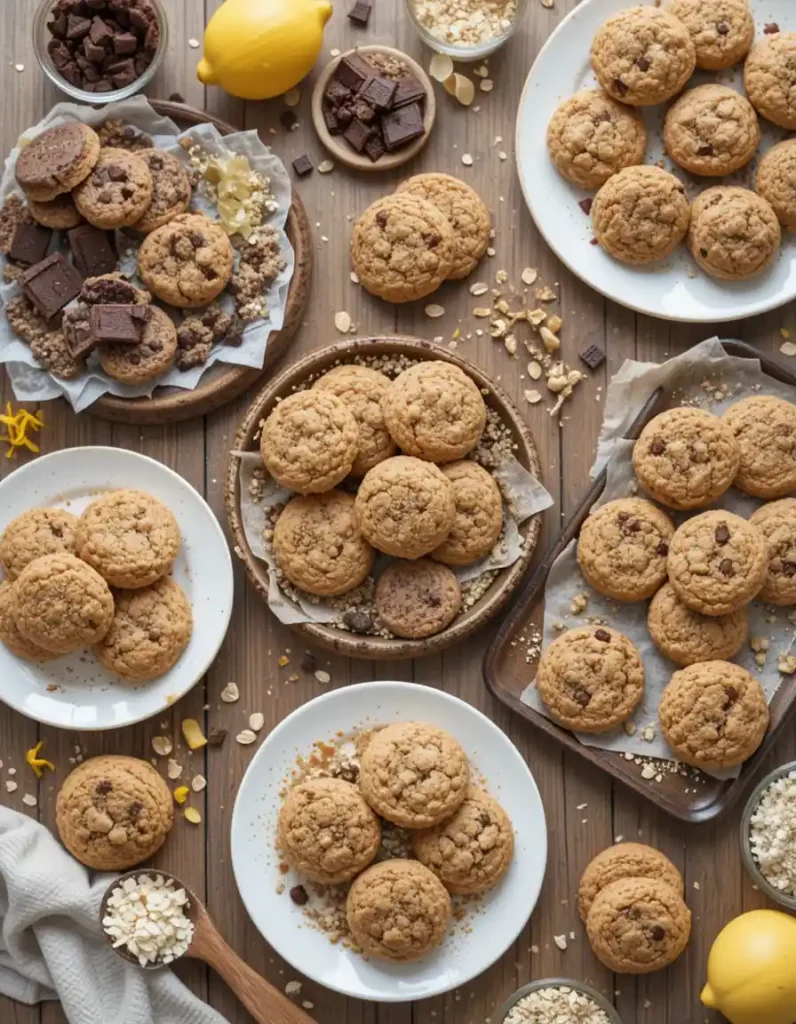
Ready to bake the perfect gluten-free cookies?
Don’t wait! Try these recipes today and experience the deliciousness for yourself. Let us know how they turn out—drop a comment below or share your baking photos on social media with the hashtag #AmazingGlutenFreeCookies. We’d love to see your creations!
Enjoyed the recipe? Leave a rating or comment below and share your thoughts!
Looking for more cookie inspiration? Check out these mouth-watering recipes:
- Cottage Cheese Cookie Dough Recipe!
- Perfect Coconut Chocolate Chip Cookies!
- Perfect Cake Mix Cool Whip Cookies
Want more delicious gluten-free recipes delivered straight to your inbox? Subscribe to our newsletter and follow us on Pinterest/Facebook for the latest baking tips and treats.
Happy Baking!
Git more recipes you might like
- Top 10 Spiderman Cake Ideas.
- Cookie Cereal Recipe.
- Perfect Star Bread.
- Aphrodisiac Chocolates.
- French Press Coffee Ratio.
- Venetian Ice Cream Flavors.
Did You Try Our Recipe?
There are no reviews yet. Be the first one to write one.

